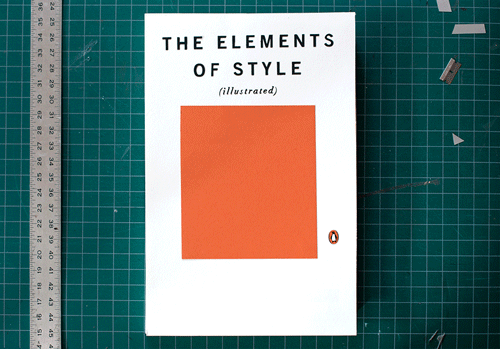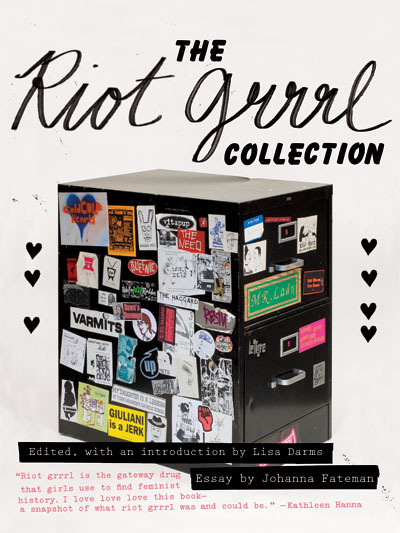The Paris Review's Blog, page 797
July 30, 2013
Elements of Style, Live
Brain Pickings’s Maria Popova has curated a fantastic selection of books for the New York Public Library’s bookstore. And that’s not all: artist Kelli Anderson did a 3-D papercraft display based on the chosen books, which, in turn, was made into a time-lapse video. It’s all great, but we couldn’t resist sharing this GIF of the Strunk, White, and Kalman Elements of Style collage being assembled.
Grrrl, Collected
A few years ago, I started a collection at NYU’s Fales Library & Special Collections to document the feminist Riot Grrrl movement in its formative and most active years, from 1989 to 1997. Originally a reaction against the failures of punk to extend its DIY model of empowerment to women, Riot Grrrl encouraged young women to form their own bands, self-publish personal stories and revolutionary agendas in zines, and carve out safe spaces in a violent, misogynist culture. Riot Grrrl was not a centralized movement, and many of the donors to the collection never called themselves “riot grrrls.” I never did, even though I went to the shows, read the zines, and identified as a punk and a feminist. Looking back, I see Riot Grrrl as descriptive of a moment as much as a movement: one that many young people now seem to want to study, learn from, and revivify. This summer, the Feminist Press published The Riot Grrrl Collection, my book of almost 350 pages of selections from the collection. Below are a few of my favorites.
This flyer, a pre–Riot Grrrl “manifesto” that was later repurposed for the minizine Riot Grrrl, is the first image in the book. Kathleen told me she made it in 1989, when she was volunteering at Safeplace, Olympia’s long-lived domestic-violence shelter and advocacy organization. Designed so that it could be folded up into a small rectangle with the word trust on top, this flyer was both a secret invitation and a public announcement, much like Riot Grrrl itself. Read More »
A Battle for Souls, and Other News
“But ultimately, I decided that the committees overseeing these sorts of things (editorial, sales, marketing) would never approve this. ‘The title is hard to read,’ they would complain. ‘The book is hard to read,’ I would silently retort. ‘That’s one of its principle merits.’” A glimpse into the process of cover design.
Stephen King on opening lines.
The London Fire Brigade blames a ten per cent increase on handcuff-related calls on Fifty Shades of Grey.
Speaking of London: “In one corner sit the tut-tutting ‘serious’ readers. In the other, flirtatious undergraduates with their iPhones and social lives. At the heart is the battle for the soul—and control—of the British Library.”
Libraries team up with airports in a campaign called, appropriately enough, Books on the Fly. Here’s how it works: “Scanning a QR code, available on cards throughout the airport, sends users to a site where they can access the Kansas State Library’s eLending service. Visitors without a library card are directed to Project Gutenberg’s mobile-optimized site, where they can download titles in the public domain.”
July 29, 2013
Senior Poetry
In Beirut, there’s a shovel-faced gremlin sitting in front of the whorehouse. I’m just passing by, and he eyes me from his perch on a coffee can, where he rocks back and forth, opening and closing his fists, one bloodshot fish-eye firmly closed, the other spinning wildly. He barks out suddenly, a sharp noise like the backfire of an old Mercedes, and I turn to see his massive feet slap the pavement in black sneakers, his chest splattered in wet cigarette ash. Checking my watch, I still have ample time before I meet Marilyn Hacker, the eminent poet, who’s agreed to an audience with my class of elderly writing students. The gremlin smacks his lips, the size and shape of small fish, and I’m happy to be rounding a corner.
Down the block, I see the lantern-jawed doorman with the scarf, patrolling his stretch of sidewalk. He’s got the chiseled chin, the squinting, seen-it-all eyes, and the mane of hair of an Arab George Clooney. Yet for all his confidence, I’ve never seen the guy do anything but smoke, smile, and gesture admiringly at some cool car and—today—the shapely form of a woman’s rear end.
On the next block, the bellhop is a puppy dog in a gray tux. Months ago, he told me he’d have a new uniform. Another day he smoothed his collar and tousled my hair. Later still, he blew me a kiss, and on another day he pretended not to see me, then yelled out my name, which I had not realized he knew. I spied him at a local grocery store, wearing a T-shirt and jeans, and in his basket was only tea and chocolate. Today he is busy. Read More »
Gin, Cigarettes, and Desperation: The Carson McCullers Diet
From Modern Drunkard:
Carson liked sherry with her tea, brandy with her coffee, and her purse with a large flask of whiskey. Between books, when she was neither famous nor monied, she claimed she existed almost exclusively on gin, cigarettes, and desperation for weeks at a time. During her most productive years she employed a round-the-clock drinking system: she’d start the day at her typewriter with a ritual glass a beer, a way of saying it was time to work, then steadily sip sherry as she typed. If it was cold and there was no wood for the stove, she’d turn up the heat with double shots of whiskey. She concluded her workday before dinner, which she primed with a martini. Then it was off to the parties, which meant more martinis, cognac, and, oftentimes, corn whiskey. Finally, she ended the day as it began, with a bedtime beer.
Her recuperative abilities are the stuff of legend—she would rise the following morning, shake off her hangover like so much dust, down her morning beer, and get back to work.
And thank you, Michelle Dean, for drawing to our attention!
The Tournament of Literary Friends
We’re tournament people, my husband and I. The way some people climb rocks or brew beer (I don’t know: What do other people do?), we draw sloppy 64-berth brackets in coffee-stained spiral-bound notebooks then set to vigorous, regimented discussion, rationally whittling down the field until an undisputed champion emerges. Notable competitions past include Most Intriguing City (Helsinki def. Buenos Aires) and Favorite Animal (Polar Bear def. House Cat). Most times, Matt is the tournament master, the committee of one who conceives and presents the field to me, which I then imperiously adjudicate, usually while reclining on a couch or airplane seat and eating something packed with butterfat. It’s a good arrangement, because he is a historian who likes categories and I am a writer who likes making things up.
For tournament people, the next bracket is always a gift. Matt’s mom visited last month, and she brought with her a 32-person field of literary characters for each of us to complete. Our champions were to be not the greatest or most iconic or most influential figures, but the characters we’d most like to have as friends.
“Would you want to be friends with Humbert Humbert?” Claire Messud had recently demanded of Publishers Weekly.
She had a point. We took Alexander Portnoy instead.
Beatrix Potter, “Study of a Spider”
Via Victoria and Albert Museum.
Yes, she may be known for her anthropomorphic animals, but Beatrix Potter’s studies of local flora and fauna show an entirely different side: that of the committed naturalist and conservationist.
Chocolate, Jerks, and Other News
We all know OMG has some years on it, but, as it turns out, so do unfriend, outasight, and hang out.
Some leaves, woman holding a birdcage for some reason, and seventeen other contemporary book-cover clichés.
According to a study in the Journal of Environmental Psychology, bookstore sales may benefit from the aroma of chocolate.
“One unexpected development of becoming a writer is meeting literary heroes … Unfortunately, sometimes they turn out to be asses, or they hit on you.”
[WARNING: the following is disturbing.] The frontispiece of this nineteenth-century book reads, “The leather with which this book is bound is human skin, from a soldier who died during the great Southern Rebellion.” And it is not an idle boast; rather, it’s an example of the (hopefully) lost art of anthropodermic bibliopegy. Read at your own risk.
July 26, 2013
Kristin Dombek’s “Letter from Williamsburg”
Il Pordenone, The Holy Trinity
This essay may sound strange, read by a man—it is so specifically a woman’s essay. But Dombek’s voice is so powerful, every time I read “Letter From Williamsburg,” I hear it in my head. It’s like a song I want to sing along to. In fact, I remember reading the first two paragraphs to our Southern editor, John Jeremiah Sullivan, over the phone, before the rest of the essay was written. I wanted him to hear how beautifully Dombek modulates her tone from the sublime to the mundane. I only wish I could do justice to the music on the page.
Read the full essay in our Summer 2013 issue.
War of the Words
Orson Welles and Henry Jaglom. Courtesy of Rainbow Films.
My Lunches with Orson, a collection of off-the-cuff conversations between filmmaker Henry Jaglom and Hollywood lion Orson Welles, recorded before Welles died of heart failure in 1985 (when his body was discovered, he had a typewriter in his lap, keystrokes from a comeback that was cruelly out of reach), arrived in bookstores last week with much fanfare. The chats were recorded weekly at the duo’s favorite restaurant, the now-shuttered Ma Maison on Melrose Avenue in Los Angeles, and were conducted not only with Welles’s consent but at his urging. The transcripts read less like a meal and more like forkfuls from a dessert cart that endlessly whizzes by. Welles stabs at topics this way and that, exposing his deepest grudges and marveling over his unmatched moments of grandeur, sometimes in the same sentence. Author Peter Biskind combed through the cassettes, dozens of which Jaglom had stashed in a shoebox, and edited them for maximum punch. In his introduction, Biskind claims this “may be the last undiscovered trove of Welles on Welles.”
Excerpts from the book, which can be snacked on online, reveal Jaglom recoiling at times as his companion blows buckshot across Hollywood. With each passing course, Welles serves up one-liners, each more potent than the last, and dismisses showbiz royalty past and present. High-powered table-hoppers are skewered the moment they’re out of earshot. Richard Burton gets the breeze. Waiters get shushed. Jaglom gets embarrassed. Even Wolfgang Puck, the chef preparing Welles’s meals, is targeted. (This was before Puck slid to Spago, the quintessential mideighties hot spot he erected off the Sunset Strip.) While Welles has no problem chortling about a leading Broadway critic who was unaware that the disgruntled staff at his favorite hotel routinely pissed in his morning tea, he doesn’t seem particularly mindful of his own tableside vulnerabilities. Read More »
The Paris Review's Blog
- The Paris Review's profile
- 305 followers













